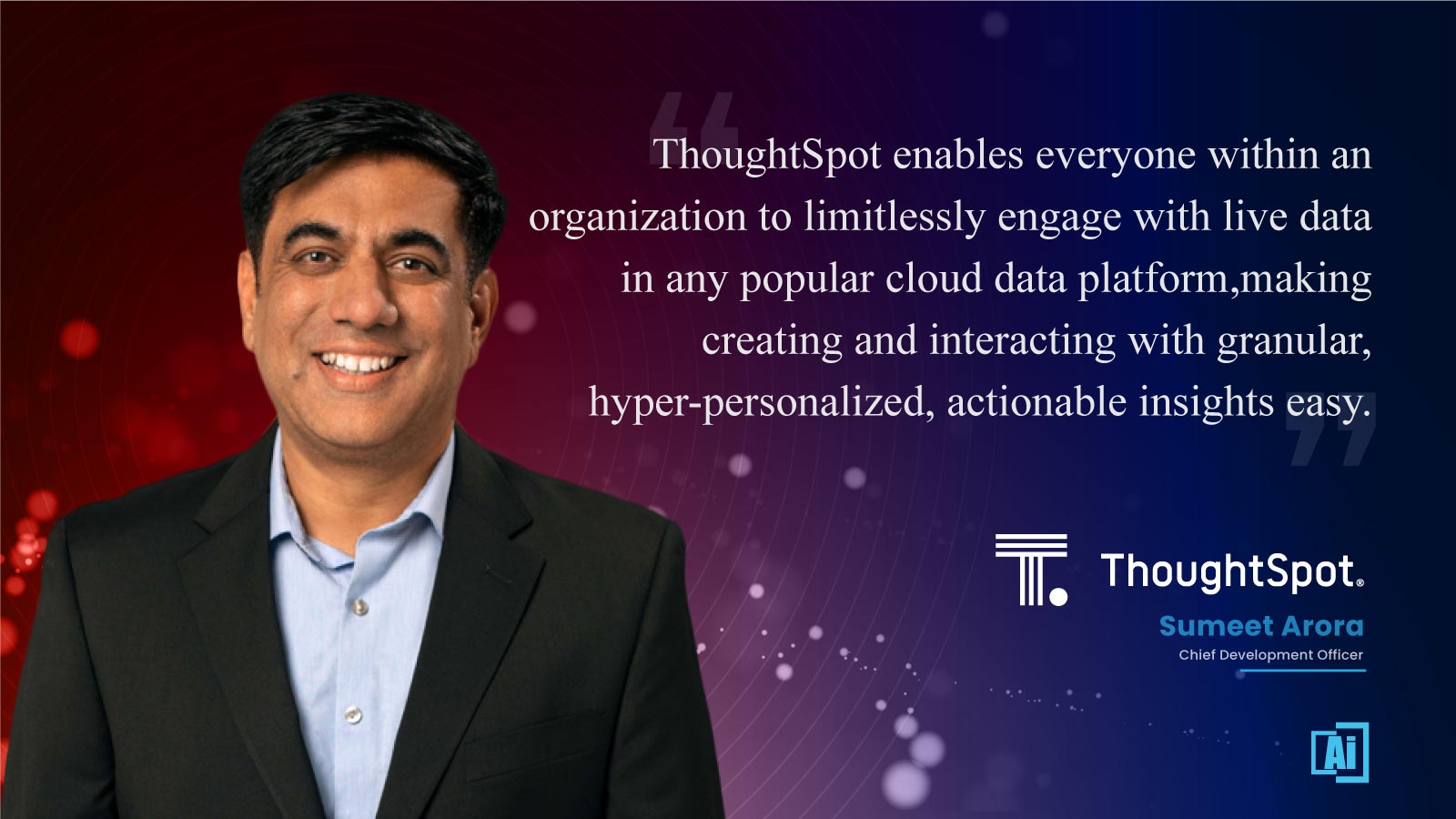AiThority Interview with Sumeet Arora, Chief Development Officer at ThoughtSpot

Hi, Sumeet, Please tell us a little bit about your role and responsibilities in your current company. How did you arrive at ThoughtSpot?
I am the Chief Development Officer at ThoughtSpot, where my primary focus is leading the company’s global Engineering and Product teams to continuously improve and scale the AI-powered data analytics platform. With a background in engineering, product strategy, and security fields and a passion for self-service software and rapid innovation, ThoughtSpot was the ideal company to continue pursuing my interests.
What is ThoughtSpot and what are your core offerings?
ThoughtSpot enables everyone within an organization to limitlessly engage with live data in any popular cloud data platform, making creating and interacting with granular, hyper-personalized, actionable insights easy. As the experience layer of the modern data stack, ThoughtSpot enables every kind of user – business user, data professional, or product builder – to improve decision-making wherever and whenever decisions are made. Amid economic downturns, layoffs, and budget cuts, this kind of autonomy is more important than ever, as disruption and change push organizations to adapt to a more data-savvy culture to keep pace with digital innovation. ThoughtSpot offers business intelligence capabilities on both web and mobile applications, while ThoughtSpot’s low-code developer-friendly platform, ThoughtSpot Everywhere, enables customers to embed AI-Powered Analytics to their products and services, monetizing their data and enhancing the overall user experience.
What are the critical challenges impeding the growth and distribution of AI in marketing and customer experience management?
Foundational models like GPT are driving an “innovation race” within businesses that are trying to figure out how to leverage capabilities for competitive advantage. Generative AI, for all its benefits, still has some maturing to do to be effective for enterprise. It gets confused when large numbers of columns are involved or when the schema is fairly complex and there are multiple fact tables. The accuracy of raw GPT is not something to write home about, especially in a data context, but is the essential criteria for success in a business setting.
As the impact of AI continues to surge in business and society, various ethical issues arise from more complex use cases. Proper data governance frameworks, tools to expose bias, and factors in transparency will be needed to stay compliant with legal and social structures. Proper model validation and audit mechanisms with inbuilt explainability and checks for reproducibility will need to become the norm for safeguarding against ethical lapses. Large language models promise to make interacting and conversing with data easier than it has ever been before, but doing so in a way that’s accurate, trustworthy, and actionable will require the kind of self-service analytics platform ThoughtSpot has spent a decade building.
Tell us more about ThoughtSpot Sage and the customer base you are targeting?
ThoughtSpot’s mission to democratize data for the masses has driven consistent innovation since its inception, and a significant priority for ThoughtSpot is conversational AI becoming a reality. ThoughtSpot pioneered search for data powered by AI, which in turn empowers users to answer the questions they know to ask while unearthing insights users wouldn’t even know to look for based on historical data.
ThoughtSpot Sage, which includes an integration with GPT, delivers a unified search experience by combining large language models like GPT with ThoughtSpot’s patented search technology, bringing natural language search, AI-generated answers, and data modeling capabilities to our existing platform. We took GPT and its outstanding abilities to create new content and insights in natural language and built machinery around it to make it work in enterprise data and analytics. We have done this in a manner such that users including analysts and power users have a role in ensuring that the system continues to learn and improve its accuracy while the combination of GPT and ThoughtSpot’s relational search technology ensures that the business continues to run on accurate results.
An “under the hood” look at our GPT integration:
When a user asks a question in natural language, Sage breaks that question into its elements, reducing billions of rows of data in the large language model to the ones that are relevant to that specific question. Sage then takes away all of the complexity in the data model in terms of joins and calculated fields and essentially hides that complexity from GPT, which isn’t known for its computational abilities.
At that point, GPT is left to do what it does best, which is natural language understanding — turning that question into a more simple SQL. Sage takes the source data model and sends that back into the real-world data model so that users can get an accurate, precisely governed SQL with all the security built into it. Sage also translates that SQL into a search language that business users have grown accustomed to over time, making the questions more understandable to the everyday user. If the question is not interpreted as intended, the user can adjust the query, get feedback, improve the overall system, and interact with the question to get the answer they really need. From that point, users can then drill down and keep drilling down in any particular direction, with all of the usual ThoughtSpot features still available at their fingertips.
How could technology platforms benefit from leveraging Generative AI?
This is an exciting time and marks the beginning of a new relationship between humans and machines. GPT-3 came into the picture and is showing a level of intelligence that we’ve never seen in Natural Language Processing algorithms before. Its ability to capture knowledge from the world based on all the training data as well as its ability to synthesize and do some reasoning based on facts is completely new. Generative AI and transformer based models like BERT, and GPT-3 are becoming more sophisticated, extending their capabilities to process semantic similarities and contextual relationships, improving upon existing applications in text summarization and generation, chatbots, and increasing translation accuracy while enhancing sentiment mining, search, and code generation.
What’s in store for the future at ThoughtSpot—what other AI tools do you plan to invest in?
We’ll continue to invest in making other foundational models available in ThoughtSpot Sage. Look, the reality is that many of these large language models are going to become commoditized. We’re already starting to see it. So whether you want to use GPT, Bard, or some other foundational model, Sage will let you do so in a way that lets you confidently and securely deploy them in your business.
But the value of AI goes well beyond that. We’re going to continue investing in SpotIQ, our AI engine that helps you ask and answer questions you didn’t even think to ask. We’re on the precipice of a new relationship between humans and machines. Tools like Sage will help humans speak to machines, while other forms of AI like SpotIQ will enable machines and systems to alert you to changes you should know about, not after they happen, but as they happen, why they are happening, and most importantly, what you can do about them.
An event/ conference or podcast that you have subscribed to consume information about B2B technology industry: If invited, would you like to be part of a podcast episode on IT/ Data Ops, CX and B2B SaaS?
A podcast I often tune into for B2B tech news and overall data industry insights and applications is “The Data Chief” with ThoughtSpot’s Chief Data Strategy Insights Officer, Cindi Howson. Her extensive experience and deep knowledge of data analytics makes her not only a thought leader in her field, but also an invaluable resource to the ThoughtSpot team.
Thank you, Sumeet! That was fun and we hope to see you back on AiThority.com soon.
[To share your insights with us, please write to sghosh@martechseries.com]
Sumeet Arora is the Chief Development Officer at ThoughtSpot. Arora leads ThoughtSpot’s global Engineering and Product teams in continuously improving and scaling the AI-powered data analytics platform. Prior to joining ThoughtSpot, Sumeet served as SVP and GM of Service Provider Networking at Cisco. In this role, he led the Engineering & Product management team for the Service Provider routing portfolio and was responsible for driving profitable market share growth of this multi-billion dollar business.
ThoughtSpot is the Modern Analytics Cloud company. Our mission is to create a more fact-driven world with the easiest to use analytics platform. With ThoughtSpot, anyone can leverage natural language search and AI to find data insights and tap into the most cutting edge innovations the cloud data ecosystem has to offer. ThoughtSpot enables everyone within an organization to limitlessly engage with live data regardless of their cloud data platform, making it easy to achieve granular, actionable insights through Live Analytics. Customers can take advantage of ThoughtSpot’s web and mobile applications to improve decision making for every employee. With ThoughtSpot’s low-code development platform, customers can also embed consumer-grade analytics into their SaaS offerings or build entirely new interactive data apps that engage users and keep them coming back for more. Organizations like Walmart, BT, T-Mobile, Snowflake, HubSpot, Daimler, Medtronic, Hulu, Royal Bank of Canada, Nasdaq, OpenTable, Workato, and Nationwide Building Society rely on ThoughtSpot to transform how their employees and customers take advantage of data.


Comments are closed.